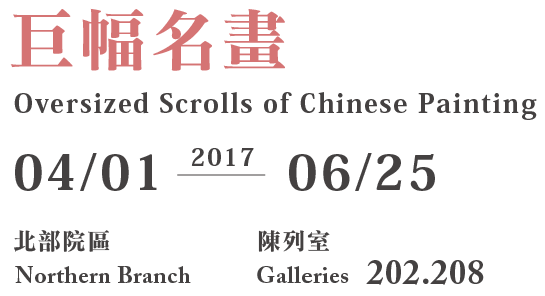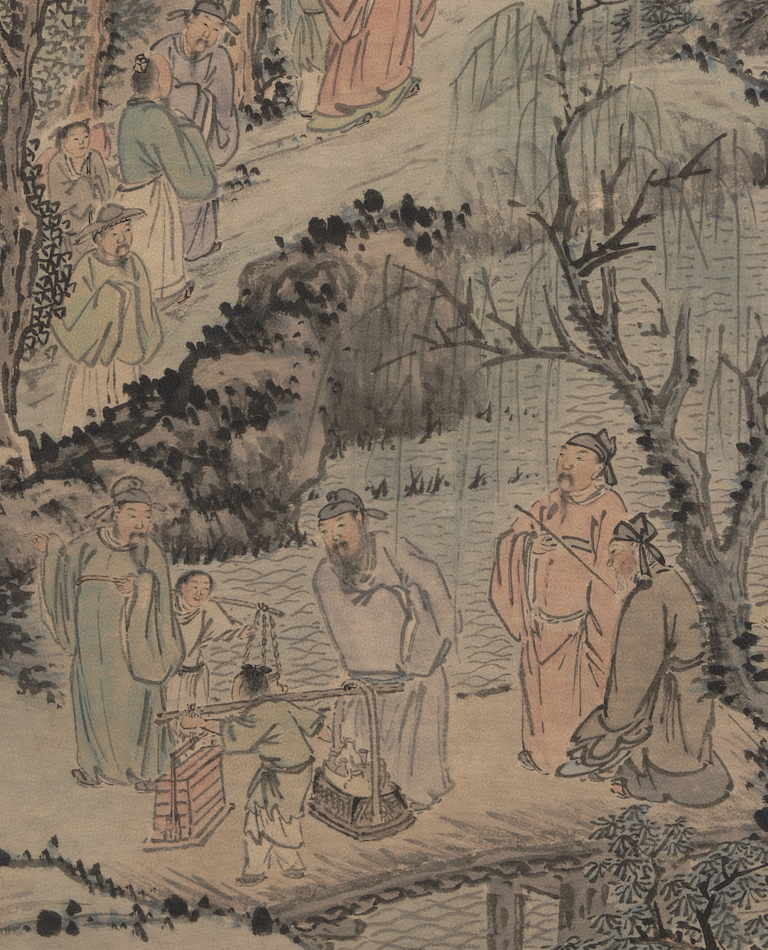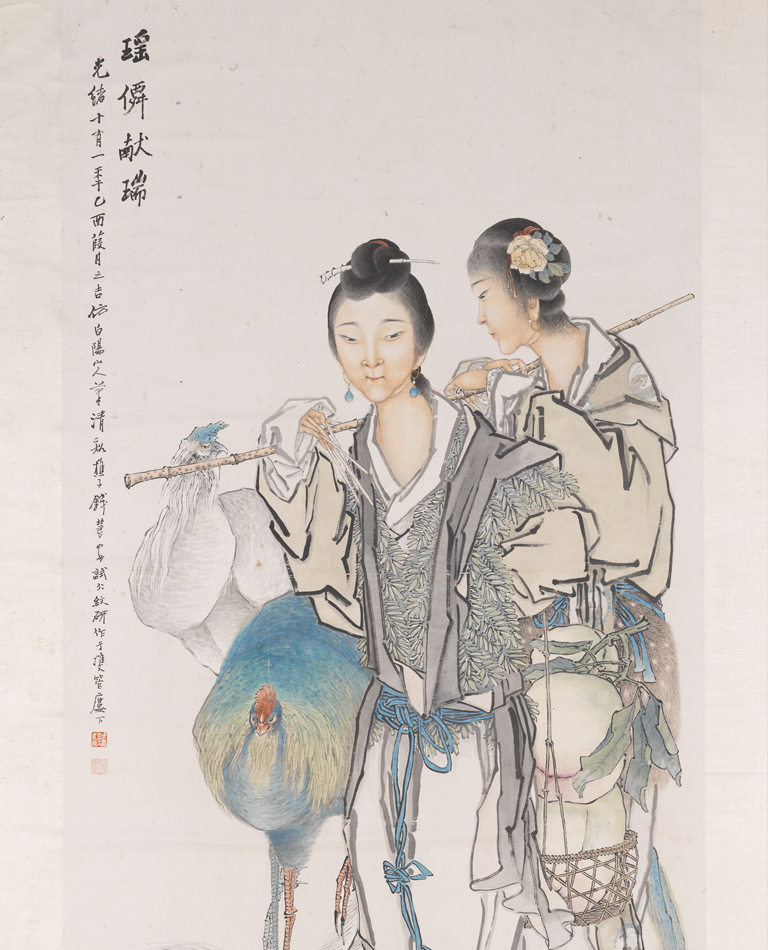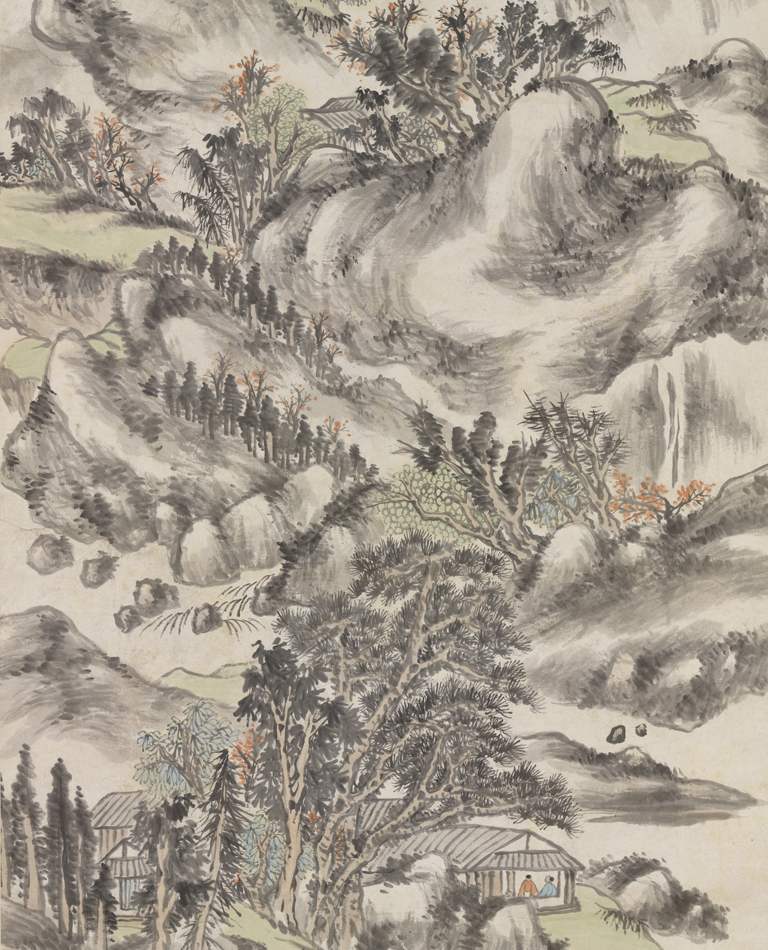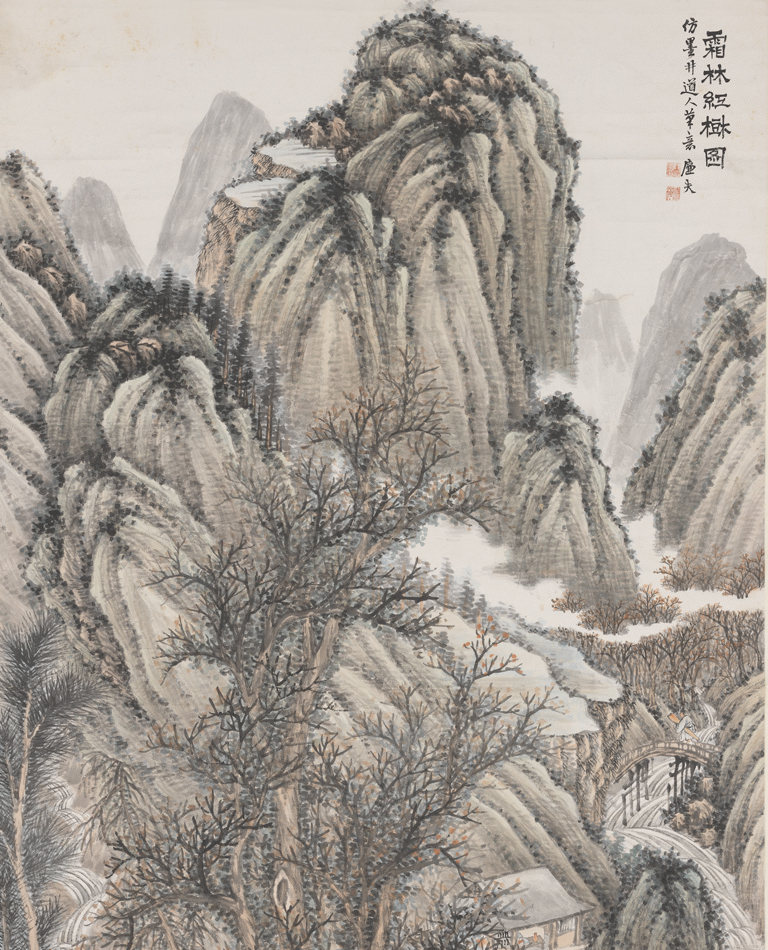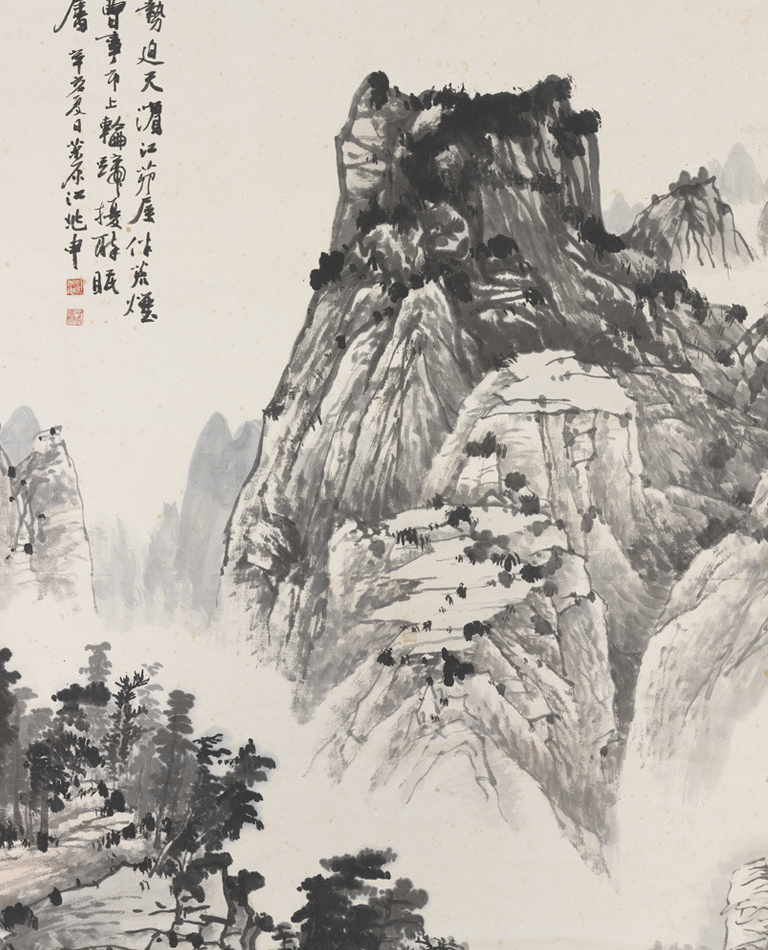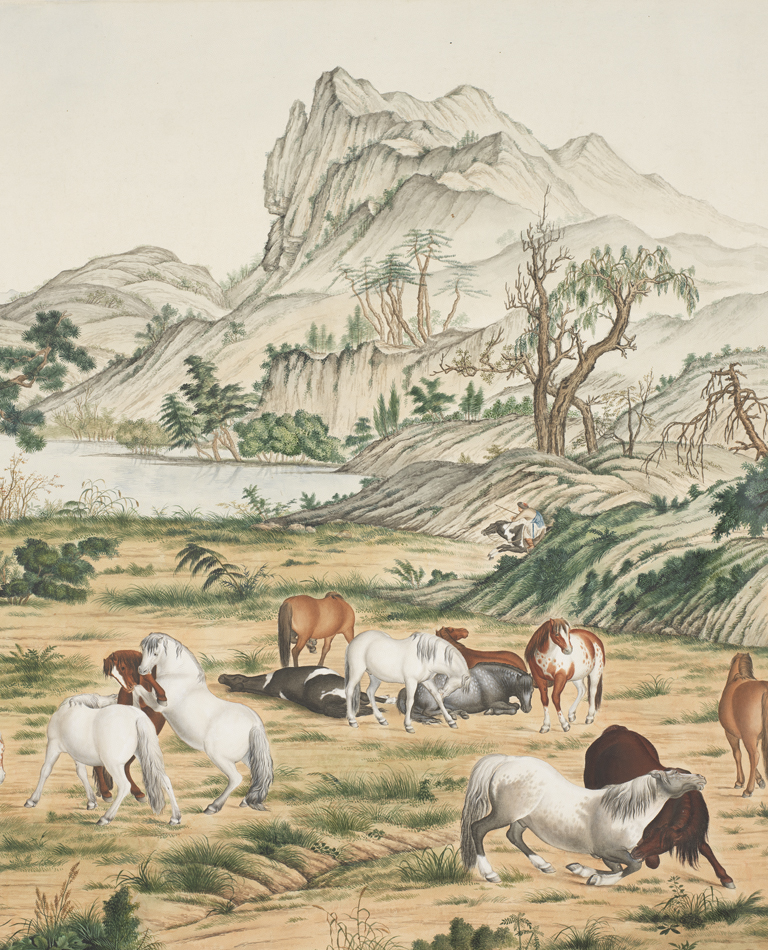Elegant Gathering of Famous Worthies
- Shen Zhou (1427-1509), Ming dynasty
- Hanging scroll, ink and colors on paper, 252.9 x 44.5 cm
Shen Zhou (style name Qi'nan, sobriquet Shitian), a native of Changzhou (Suzhou) in Jiangsu, was gifted at poetry and prose as well as calligraphy. In painting, he was especially skilled at landscape, bird-and-flower, and figural subjects. He was one of the Four Ming Masters.
On the seventeenth day of the third lunar month of "jiyou" year in the Hongzhi reign (1489), thirteen scholar-friends held a banquet at Xuzhou to bid farewell to Magistrate Wu Yu. They also wrote poems and asked Shen Zhou to paint and inscribe this painting as a memento of the occasion. The coloring here is elegant, and the drapery lines of the figures vary from fine to coarse, in which the brushwork appears sketchy but also with a fine and controlled manner. Since the scroll is tall and narrow, the hills have been compressed in a zigzag manner to increase the sense of high distance and expansive space.
Maiden Immortals Offering Auspicious Gifts
- Qian Hui'an (1833-1911), Qing dynasty
- Hanging scroll, ink and colors on paper, 244.2 x 121.2 cm
Qian Hui'an (style name Jisheng; sobriquets Shuangguan lou, Qingxi qiaozi), a native of Baoshan (part of modern Shanghai), studied the painting styles of Chen Hongshou, Huang Shen, and Fei Danxu, being also influenced by New Year folk images as well. In addition, he assimilated techniques from Western painting, becoming a famous figure artist of the Shanghai School.
The figures in this painting are done with firm brushwork, the spirit refined and elegant. The artist's inscription states that the scroll is in the brush manner of "Baiyang shanren," referring to the Ming artist Chen Chun (1484-1543). The result is a style that incorporates both modern and ancient for a fresh atmosphere fully reflecting the time in which Qian lived. These immortals are bringing peaches of immortality as an offering of long life, conveying auspicious and celebratory meaning.
This work is thus a typical example of a popular decorative subject for birthday blessings among the people that Qian incorporated in his painting.
Landscape
- Pu Hua (1830-1911), Qing dynasty
- Hanging scroll, ink and colors on paper, 241 x 117 cm
Pu Hua (original name Cheng; style names Zhuying, Zuoying; also known as Xushan waishi) was a native of Jiaxing in Zhejiang, but he spent much of his life in Shanghai. Studying flower painting in his early years, his style was somewhere between that of the Ming dynasty artists Xu Wei and Chen Chun. He later studied bamboo painting as well, particularly admiring the style of the Song scholar-artist Wen Tong. Pu's landscapes, trees, and rocks possess an extremely wet manner in the styles of the Qing dynasty individualists Shitao and Shixi, to which he added his own variations.
The brushwork in this scroll has a beautifully elegant atmosphere within the simple archaism, the lines fluid yet condensed for a sense of strength in the softness. At the bottom of the painting are some trees on a slope concealing buildings, in which figures appear to make for a refined scene. The overall idea of the composition is innovative and full of lyricism, the work having been done at the age of 47 by Chinese reckoning.
Red Trees and Frosty Forests
- Lu Hui (1851-1920), Republican period
- Hanging scroll, ink and colors on paper, 245.6 x 123.2 cm
Lu Hui (original name Youkui, style name Lianfu; sobriquets Juan'an, Pofo'an zhuren) was a native of Wujiang in Jiangsu. He excelled at painting and calligraphy, learning landscapes from Tao Yisun. Early in his study of flower painting he followed Liu Deliu and traced back to the tradition of the famous artist Yun Shouping. After his works came to the attention of Wu Dacheng, Lu was invited to stay at his residence. Studying Wu's collection led to dramatic changes in Lu Hui's style.
This hanging scroll depicts the colors of a subdued autumn scene. The painter's inscription in the upper right corner states it was done in imitation of a work by "Mojing daoren," referring to the famous Qing dynasty artist Wu Li (1632-1718). The brushwork in the scenery of rocks and trees, however, is marvelously sophisticated for a force that is simple yet powerful, brimming instead with Lu's own sense of pure and beautiful harmony.
Piled Ridges of Layered Peaks
- Chiang Chao-shen (1925-1996), Republican period
- Hanging scroll, ink and light colors on paper, 377.2 x 146.4 cm
Chiang Chao-shen (style name Jiaoyuan), a native of Shexian, Anhui, came to Taiwan in 1949. After studying art under Pu Hsin-yu, he came to serve as a researcher at the National Palace Museum, rising to the posts of Chief Curator at the Department of Painting and Calligraphy as well as Deputy Director. He also excelled at the "Four Perfections" of poetry, calligraphy, painting, and seal carving, likewise being accomplished in art history and connoisseurship, too.
The composition of this painting has been arranged most pleasingly to express a sense of depth to the landscape as well as majesty to the peaks layered into ridges. The brush method is marvelous and fluid with a great deal of variety, the ink moist and spreading in abundant tones that reveal the lofty and untrammeled spirit of the traditional literatus.
Mr. Sung Ying-san donated this painting to the National Palace Museum in 2001.
One Hundred Horses
- Ma Chin (1900-1970), Republican period
- Handscroll, ink and colors on paper, 98.2 x 827.8 cm
Ma Chin began his study of painting in 1922 under Jin Cheng and specialized in horses. Following the style of Lang Shining (Giuseppe Castiglione, 1688-1766), the Italian artist at the Qing court, he also did bird-and-flower subjects and practiced other art forms, including calligraphy, seal-carving, and even kite-making. Before becoming an instructor at the Peking Painting Academy, he earned a living by selling his paintings.
This scroll, done in 1923, represents an early work in Ma's study of painting. A copy of "One Hundred Horses" by Giuseppe Castiglione formerly in the Qing court collection and now in the National Palace Museum, the brushwork is delicate and the coloring beautiful.
At the end of the scroll is an inscription by Yu Yu-jen (1879-1964) in cursive script dated to 1952. General Ho Ying-chin (1890-1987) bequeathed this work to the National Palace Museum.
